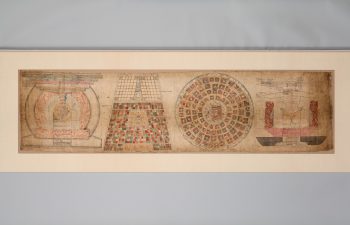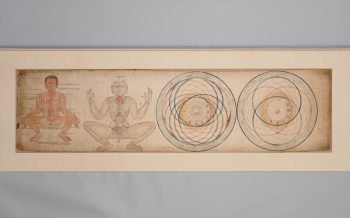Tibet
16th century


Tibet
16th century


This eight-panel, double-sided scroll presents diagrams exploring various aspects of the cosmos as described in the Buddhist text called the Wheel of Time (Kalachakra) Tantra. This tantra emphasizes the correlations between the outward appearances of the universe and the human body.Kalachakra CosmosThis fully annotated diagram of the Buddhist cosmos renders all of the essential elements of the Kalachakra system’s understanding of upper-world topography, and displays them both from above and from the side. It focuses particularly on Mount Meru, which is believed to sit at the center axis of the cosmos. Meru’s base, or foundation, consists of four round disks that represent (from bottom to top) air, fire, water, and earth.The Cosmic ManThe human body represents a complex inner cosmology with direct correlations to the universe. Branching off from the vertical central channel of this “cosmic man” are six centers, or chakras, associated with the six elements: space, located at the crown; water, at the forehead; fire, at the throat; wind, at the heart; earth, at the navel; and awareness, at the genitals. In addition to these primary chakras, the painting also depicts the chakras at the main joints — shoulders, elbows, wrists, hips, knees, and ankles — which correlate to the twelve signs of the zodiac. The figure’s fingers, correspond to the five elements.
A religious movement that originated in India around the fifth to seventh century with sacred writings and esoteric teachings and practices transmitted from teacher to student through initiation. These remain an important part of Hinduism and Buddhism today.
Teachings and precepts that offer practical and experiential guidance. In Buddhism instruction is primarily an oral tradition and is often targeted to the specific needs or disposition of a student or disciple.
A vehicle for the preservation and transmission of knowledge. The Buddha’s teachings were originally passed down through oral transmission and storytelling, and stories of the Buddha’s past lives are considered an important source of inspiration and guidance.
Today, Tibetans primarily inhabit the Tibetan Plateau, situated between the Himalayan mountain range and the Indian subcontinent to the west, Chinese cultural regions to the east, and Mongolian cultural regions to the northeast. During the 7th to 9th century, Tibetan rulers expanded their empire across Central Asia, and established Buddhism as the state religion.
Get the latest news and stories from the Rubin, plus occasional information on how to support our work.